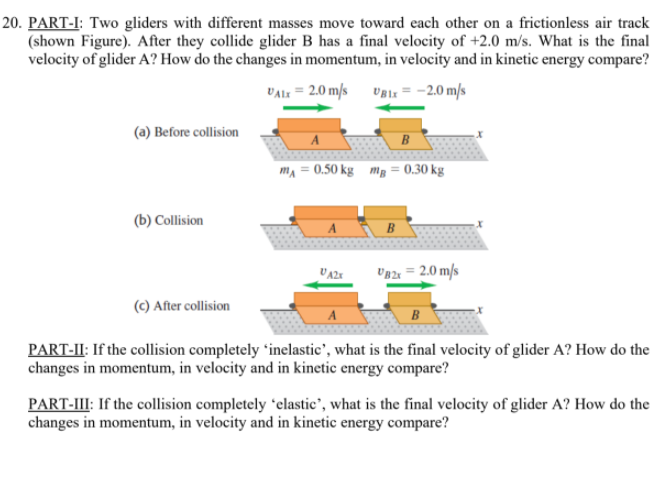20. PART-I: Two gliders with different masses move toward each other on a frictionless (shown Figure). After they collide glider B has a final velocity of +2.0 m/s. What is velocity of glider A? How do the changes in momentum, in velocity and in kinetic energy e VAL = 2.0 m/s vRx = -2.0 m/s (a) Before collision m, = 0.50 kg mp = 0.30 kg (b) Collision B Uaz = 2.0 m/s (c) After collision B PART-II: If the collision completely 'inelastic', what is the final velocity of glider A? Ho changes in momentum, in velocity and in kinetic energy compare? PART-III: If the collision completely 'elastic', what is the final velocity of glider A? Hov changes in momentum, in velocity and in kinetic energy compare?
20. PART-I: Two gliders with different masses move toward each other on a frictionless (shown Figure). After they collide glider B has a final velocity of +2.0 m/s. What is velocity of glider A? How do the changes in momentum, in velocity and in kinetic energy e VAL = 2.0 m/s vRx = -2.0 m/s (a) Before collision m, = 0.50 kg mp = 0.30 kg (b) Collision B Uaz = 2.0 m/s (c) After collision B PART-II: If the collision completely 'inelastic', what is the final velocity of glider A? Ho changes in momentum, in velocity and in kinetic energy compare? PART-III: If the collision completely 'elastic', what is the final velocity of glider A? Hov changes in momentum, in velocity and in kinetic energy compare?
Related questions
Question

Transcribed Image Text:20. PART-I: Two gliders with different masses move toward each other on a frictionless air track
(shown Figure). After they collide glider B has a final velocity of +2.0 m/s. What is the final
velocity of glider A? How do the changes in momentum, in velocity and in kinetic energy compare?
VAlr = 2.0 m/s UBIX
-2.0 m/s
(a) Before collision
A
B
m, = 0,50 kg mg = 0.30 kg
(b) Collision
A
B
Ua2 = 2.0 m/s
(c) After collision
A
B
PART-II: If the collision completely 'inelastic', what is the final velocity of glider A? How do the
changes in momentum, in velocity and in kinetic energy compare?
PART-III: If the collision completely *elastic', what is the final velocity of glider A? How do the
changes in momentum, in velocity and in kinetic energy compare?
Expert Solution
This question has been solved!
Explore an expertly crafted, step-by-step solution for a thorough understanding of key concepts.
This is a popular solution!
Trending now
This is a popular solution!
Step by step
Solved in 3 steps
